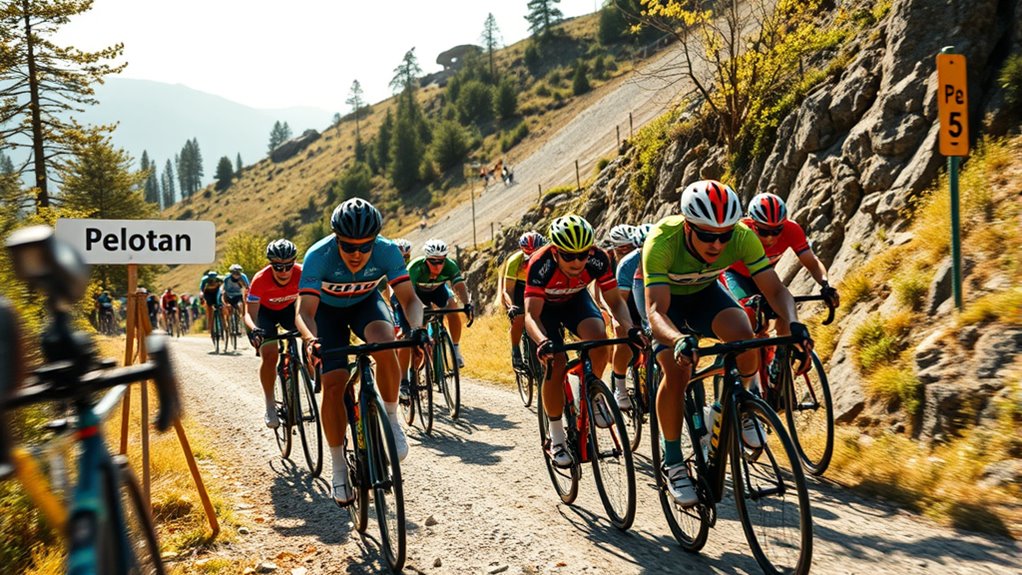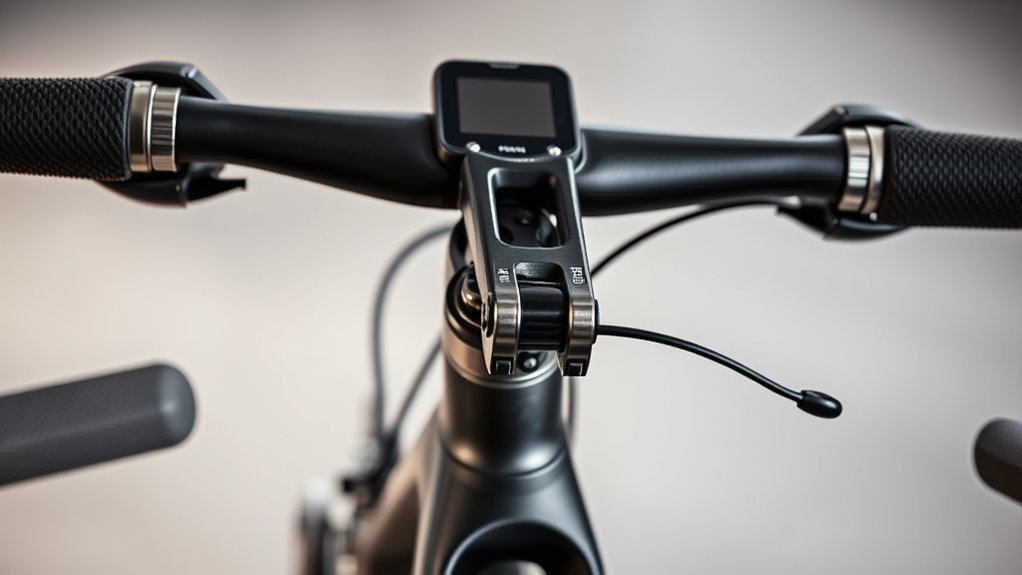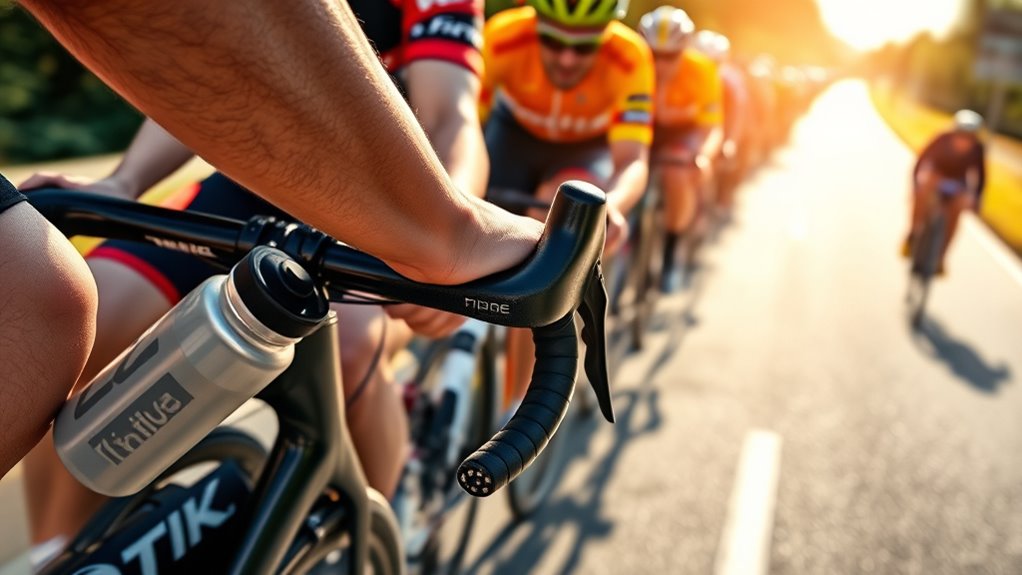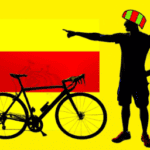To understand cycling jargon, start by learning key terms like cadence, drafting, lead-out, and breakaway, which explain race tactics. Know about gears like chain rings and cogs, plus components such as hubs, rims, and brake systems that keep your bike running smoothly. Familiarize yourself with roles like domestiques and sprint specialists, as well as race formats like stage races and time trials. Mastering this language will help you communicate effectively and improve your riding skills—there’s much more to discover.
Key Takeaways
- Familiarize yourself with common cycling terms like “cadence,” “drafting,” “gear,” and “peloton” to understand race strategies.
- Learn technical component names such as “derailleur,” “cassette,” “rim,” and “hub” for maintenance and communication.
- Understand racing tactics like “lead-out,” “breakaway,” “climbing,” and “sprint” to grasp race dynamics.
- Know roles like “domestique,” “rouleur,” and “leader” to comprehend team strategies and rider functions.
- Recognize cultural and support-related terms like “support roles” and “support crew” to appreciate race logistics and camaraderie.
Common Race Formats and Their Characteristics

Understanding the different race formats is key to appreciating cycling events. Road races are open-road competitions with diverse terrain and distances, demanding endurance and strategy.
Understanding race formats helps appreciate cycling’s diverse challenges and strategies.
Time trials test individual riders against the clock over a fixed course, highlighting pure speed and pacing.
Team time trials involve groups working together to set the fastest collective time, emphasizing coordination.
Critériums are short, fast races on closed circuits, often with multiple laps, perfect for explosive efforts.
Stage races span several days, with riders competing across different stages to accumulate the lowest overall time.
Track cycling offers disciplines like scratch races, where the first to finish wins, and points races, which reward sprints and lap gains.
Each format challenges riders differently, showcasing versatility and skill in the sport.
In addition, understanding different race formats helps in recognizing the diverse terrain and distances that demand specific skills and strategies from riders.
Essential Bike Components and Their Functions

Your bike’s performance and safety depend on its essential components working seamlessly together. The frame provides the backbone, with parts like the head tube for steering and the seat tube to hold your saddle.
The drivetrain includes the chain, crankset, rear derailleur, cassette, and bottom bracket, transforming your pedaling into forward motion and allowing gear changes. Proper maintenance of these parts ensures smooth shifting and efficiency, especially when adjusting gear ratios.
Braking systems like caliper or disc brakes ensure you can stop safely, controlled by brake levers and pads.
Wheel components such as tires, spokes, hubs, rims, and valves form the contact points with the ground, enabling smooth rolling and traction.
Control interfaces, including handlebars, shifters, saddle, pedals, and stem, connect you to your bike, giving you steering, power transfer, and comfort. Regular inspection and proper adjustment of these control interfaces can significantly enhance your overall riding experience.
Ensuring these parts are well-maintained enhances your overall riding experience and keeps your bike functioning reliably.
Fundamental Riding Techniques and Strategies

Mastering fundamental riding techniques and strategies is essential for riding efficiently, safely, and confidently. Proper positioning ensures comfort and ideal power transfer; a professional bike fit can help you achieve this by adjusting saddle height and handlebar placement.
Mastering fundamental techniques ensures safe, efficient, and confident riding with optimal comfort and power transfer.
Maintaining a cadence of 70 to 90 revolutions per minute boosts efficiency and reduces fatigue. Good balance and control are crucial, especially at high speeds or when cornering.
When cornering, lean the bike appropriately, focus on the apex, and use both brakes carefully—preferably the rear brake—to stay stable.
Effective gear shifting involves anticipating terrain changes and avoiding cross-chaining to prevent wear.
Consistently practicing these techniques will improve your riding smoothness, safety, and overall performance on the road.
Key Cycling Gear and Equipment Terms

Ever wondered what all those cycling terms really mean? When you talk about gear, you’re referring to essential components like chain rings, cogs, and cranks.
Chain rings are the sprockets on the front, connected to the pedals via cranks that transmit your power. Cogs are the sprockets on the rear wheel, shifting to change gears and make pedaling easier or harder. Different gear setups can significantly impact your riding efficiency and comfort. Understanding Ford Tuning concepts can help you optimize your bike’s performance just like tuning improves a vehicle’s power and efficiency.
Wheels include rims, hubs, and tires, directly impacting ride quality and performance. The frame is the main structure holding everything together, providing stability and support. Selecting the right wheel and tire configurations can optimize your bike’s handling and speed. Additionally, advancements in robotics integration are influencing modern cycling accessories, making rides more efficient and enjoyable.
Different bikes, like road, mountain, or commuter bikes, emphasize specific gear setups. Knowing these terms helps you select the right equipment, maintain your bike properly, and communicate confidently with fellow riders. Understanding how to change gears smoothly is also crucial for maintaining cadence and momentum during your ride. Recognizing soulmate angel numbers can also help you gain insight into your relationship journey and timing.
Roles and Positions Within a Cycling Team

Understanding the various roles and positions within a cycling team is essential for grasping how races are strategized and executed. The leader is your main rider aiming for victory, protected by teammates. The road captain guides tactics during the race, communicating with the director who offers real-time instructions from the team car.
Avant-cours scouts routes ahead of the peloton’s arrival, while domestiques support by fetching supplies and shielding leaders. Specialized riders like sprinters, climbers, puncheurs, and rouleurs focus on their strengths, whether explosive finishes or navigating tough terrains. The importance of team strategy becomes evident in how these roles coordinate to optimize overall performance. Effective communication and role clarity are fundamental for a cohesive team effort during the race.
Support crew members, including mechanics, medical staff, and nutrition teams, keep the team functioning smoothly. Tactical roles such as lead-out trains, breakaway specialists, and water carriers help execute race strategies effectively, ensuring the team maximizes its chances of success. Incorporating holistic health practices can enhance rider endurance and recovery throughout the season. Additionally, understanding the role of support staff highlights the significance of non-riding personnel in maintaining team success.
Discipline-Specific Terminology and Race Dynamics

Discipline-specific terminology and race dynamics are essential for grasping how cycling competitions unfold and how riders strategize during events. Understanding terms like attack and breakaway helps you recognize when a rider tries to gain an advantage or escape the peloton.
In cyclocross, you’ll hear about obstacles and bike carries, while in time trials, riders compete solo against the clock. The mountains classification highlights the best climbers, often competing for the polka dot jersey.
Race dynamics involve drafting, where riders conserve energy behind others, and jam, which describes frantic high-speed efforts. Knowing how sprints work and what kicks are will help you follow race finishes.
These terms reveal how riders execute tactics, respond to moves, and ultimately compete for victory.
Critical Terms for Endurance and Support Events

Have you ever wondered what sets endurance cycling events apart from traditional races? These events emphasize stamina, self-sufficiency, and long-distance riding. Ultra cycling includes ultramarathons, multiday races like RAAM, and sportive rides focused on comfort and endurance.
Support roles are vital—domestiques fetch supplies, protect teammates, and sacrifice personal results, while soigneurs handle logistics and recovery. Mastering support roles is crucial for success in these challenging events, as they often require extensive planning and coordination. The ability to adapt to changing conditions and maintain team cohesion is also essential for navigating the complexities of endurance events.
Rider classifications like rouleurs excel on flat terrain, and lantern rouges are the last in the pack, sometimes protected strategically. Butter’s significance in cultural rituals and artistic expressions highlights the importance of understanding traditional cultural symbols, which often extend into sports and communal activities. Additionally, understanding navigation techniques can greatly enhance a rider’s ability to stay on course during unsupported events.
Pacing strategies such as negative splits and interval training optimize endurance, while concepts like bonking highlight the importance of proper nutrition. Proper nutrition management can significantly influence performance and recovery during extended rides.
Navigation relies on brevet and audax formats, often requiring self-supported riding with gear like bidon cages and relief saddles.
Understanding the ethical hacking process and methodologies can help improve cybersecurity measures during endurance events, especially as digital technology becomes more integrated into race management and tracking.
These terms help you understand the unique demands of endurance and support events.
Special Terms for Competitive Sprinting and Climbing

Ever wondered what makes competitive sprinting and climbing strategies so distinct in cycling? Sprinting relies on tactics like drafting and lead-out to conserve energy and set up a powerful kick at the finish. Riders often perform a wind-out to gradually build speed before releasing their final burst. Understanding the importance of cycling jargon can help you better grasp race dynamics and improve your own performance. For example, the family background of some riders can influence their approach and mental toughness during races, adding an extra layer of strategy. Recognizing how antioxidants in nutrition can support recovery and endurance might influence a rider’s preparation and recovery strategies.
In contrast, climbing focuses on King of the Mountains points and Hors Categorie ascents, where lightweight bikes and compact gearing are essential. Strategies include forming a gruppetto to save energy and maintain pace on tough climbs. Knowing these terms helps you understand the precise tactics and gear choices that separate sprinting and climbing in competitive cycling.
Frequently Asked Questions
What Does “Riding Clean” Mean in Cycling?
When you hear “riding clean” in cycling, it can mean two things. Usually, it refers to riding a bike that’s freshly cleaned, showing pride in bike maintenance.
But more importantly, it means competing without doping, staying true to the sport’s integrity. As a cyclist, riding clean shows dedication to fair play and sportsmanship, and it reflects a lifestyle that values honesty, effort, and respect for cycling’s traditions.
How Do I Choose the Right Gear Ratio for Climbs?
When choosing the right gear ratio for climbs, you want to prioritize lower ratios that make pedaling easier. Think about steepness—use gear setups like 34/50 with 11/32 cassettes or even 1x systems with larger cassettes like 10/44.
Adjust based on your fitness, cadence, and terrain. Lower ratios reduce fatigue and help you maintain a steady, comfortable cadence on tough climbs.
What Is the Significance of “Rider Weight” in Racing?
When considering rider weight in racing, it’s essential because it directly impacts your performance.
Lighter riders usually excel in hill climbs and conserve energy better, especially over long distances. Your weight influences acceleration, speed, and efficiency.
To optimize your results, focus on maintaining a healthy, strong body weight tailored to your goals and race type.
Balancing weight with strength and power yields the best performance gains on the course.
When Should I Use “Counter-Steering” During Rides?
Imagine steering a sailboat through shifting winds—you use counter-steering to keep your course true.
You should use it when you’re riding fast, approaching sharp corners, or on tricky surfaces. It’s your quick, subtle nudge to the front wheel that prompts your bike to lean into the turn.
Practice makes perfect, so get comfortable with the feel of counter-steering, and you’ll navigate curves with confidence and control.
What Does “Breaking Away” Really Involve?
Breaking away means you’re trying to separate yourself from the main peloton during a race. You do this by riding ahead of the group, often with a small team or solo, aiming for a stage win or to force others to chase.
It requires strategic timing, strong effort, and teamwork. If successful, you gain visibility for your sponsors and improve your chances of victory, but it’s risky and demands excellent pacing.
Conclusion
Now that you’re familiar with cycling jargon, you’re better equipped to hit the road or compete with confidence. Remember, understanding these terms isn’t just about sounding knowledgeable—it’s about truly connecting with the sport. So next time you’re out riding or watching a race, ask yourself: aren’t these terms just the language that makes cycling even more exciting and fun? Keep learning, keep pedaling, and enjoy every mile ahead!
















